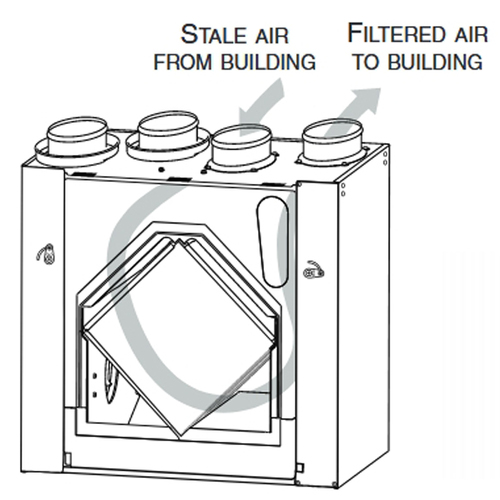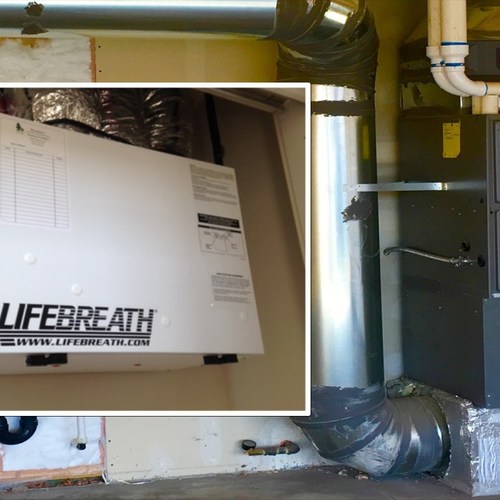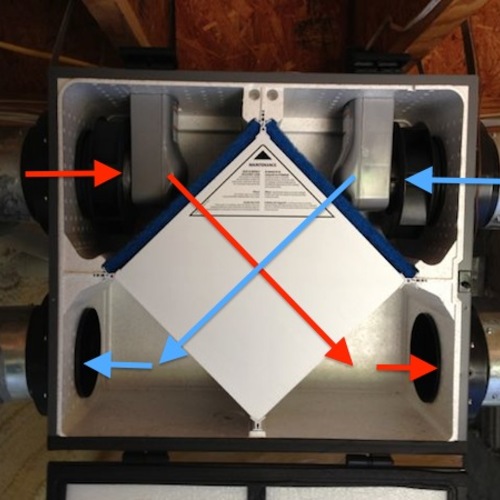
“Build tight, ventilate right” is a phrase becoming increasingly familiar to high-performance builders. It means that as houses get tighter and better insulated, the need for well-designed mechanical ventilation gets more compelling.
At its simplest, this means using kitchen and bathroom fans to remove moist or particulate-laden air. In this exhaust-only approach, outside air finds its way into the building via gaps in the building enclosure. Supply-only ventilation works the other way: fans bring fresh air into the house but there’s no dedicated path for stale indoor air to leave. Both of these approaches are economical but have drawbacks.
A more effective option is a balanced ventilation system in which incoming air is offset by an equal volume of outgoing air, which keeps air pressure in the building close to neutral. Builders and designers who specialize in superinsulated houses with very low air leakage rates now are likely to include either a heat- or energy-recovery ventilator in the plans. These mechanical systems are similar in that they have a core through which both incoming and outgoing air travel to transfer energy and, in the case of ERVs, moisture.
In a heat-recovery ventilator, or HRV, there’s an exchange of thermal energy across the core. This is what engineers call “sensible heat.” In winter, exhaust air transfers some of its thermal energy to incoming fresh air, reducing much of the energy loss that would otherwise take place. In an energy-recovery ventilator, or ERV, there is an exchange of sensible heat but also an exchange of moisture, or “latent heat.” (These systems also are called enthalpy-recovery ventilators.) In both winter and summer, ERVs are designed to keep indoor humidity levels more comfortable.
A newer generation of ventilator substitutes a conventional ERV core with a heat pump. The units provide heating and…
Weekly Newsletter
Get building science and energy efficiency advice, plus special offers, in your inbox.

This article is only available to GBA Prime Members
Sign up for a free trial and get instant access to this article as well as GBA’s complete library of premium articles and construction details.
Start Free TrialAlready a member? Log in















29 Comments
The idea that ventilation can be "more effective than medication" (third to last paragraph) needs to be supported by scientific evidence, critically examined by the author, or omitted entirely. Regurgitating unsupported claims, even if attributed to a knowledgeable sales executive, falls far short of the quality and judgement I expect from GBA and other Taunton publications.
Bryan,
I'm sympathetic to your position. (For more on this topic, see "Ventilation Rates and Human Health.")
That said, there seems to be a great deal of interest in this topic in light of the Covid pandemic, so I'll be revisiting the topic in a future article.
That actual quote is "can be" not "is".
Bryan, I agree with the desire for scientific rigor, but I think the specific line in full provides a bit more context than 'more effective than medication.'
The actual line is "...“preventive medicine” that can be more effective than medication people have to take after they’ve developed health problems because of exposure to air pollutants in their own homes."
For one, it says 'can.' Doesn't let them off the hook entirely, but at least provides a qualifier.
More importantly, it refers to medication people would have to take as a result of exposure to indoor air pollutants. If a pollutant is sufficiently removed so as not to even cause an illness, its hard to imagine a medicative treatment as being dubbed 'more effective.' It might depend on what is meant by 'effective.' The medication could perhaps be very cheap (probably not though) and therefore 'effective', but I would personally consider avoidance of said illness more desirable than having to take medicine. We could also argue that even before ventilation, one should eliminate any introduction of said pollutants into the home entirely--when possible.
What does need scientific backing (and is probably your real point) is the effectiveness of ventilation to eliminate said pollutants and thus reduce or eliminate the cause of illness. There are quite a few studies that discuss quantitative air quality results with ventilation. But it's indeed difficult to make the next leap towards anything definitive when it comes to anything health related, especially in regards to Covid where the scientific body of evidence is still very young, and because it's exceedingly difficult to isolate factors in human health.
You and Charlie are both quite correct on "can" vs. "is." Thanks for pointing it out. I updated my post, but it doesn't alter my point.
The third to last paragraph repeats a non-statement from a sales executive. Part of a journalist's job is to be skeptical and provide context. I think the last few paragraphs fell short in that regard, in what was otherwise a good overview of a frequent Q&A topic. I understand mechanical ventilation "can dramatically improve health" is a better pitch than "mechanical ventilation is necessary for moisture and odor control, and probably has health benefits for some people that are difficult to isolate, measure and quantify"--but there is no obligation for a reporter to present either piece of information without context.
Bryan et al....Yus guy's critism over the implication that the phrase "more effective than medication" is pure BS (Bovine Skatt).... It is well established that medicine has consistently been in the top five leading causes of death in the U.S. for many years. The tenants of the disciple are (A) Drugs, (B) Cut it Out or (C) Radiate it. Even the suggestion that ingesting or injecting synthetic chemicals/drugs in humans is remotely healthier than fresh air ventilation is nonsense. Such an unfounded theory has nothing to do with science. I recommend you adjust your paradigms. Maybe start with looking up a lady named Florence Nightingale. Even Ben F had a thing to say about it.
Right on Danny. To the less intelligent, medicine is the ONLY answer. They are also usually the most unhealthy people. The health benefits of fresh air is well documented. To suggest that the author needs to prove it is beyond asinine.
A previous article had a comment about a dual core combo HRV/ERV in a single unit, but no manufacturer or model was mentioned. Do we have any discussion of pros and cons of such a unit (and who makes them)?
Zehnder has units with swappable cores, and I think some others do too. I have one, and at the end of the summer, when my indoor humidity has snuck up higher than I'd like, I am watching the outdoor dew point, eager for some good dry days. As soon as we are getting those consistently, without tropical air expected to blow in, I swap in the HRV core and try to flush out that humidity. That mostly works out, although there are usually some days where the dew point swings back up and I wish I hadn't swapped it so early.
Then when the indoor humidity gets down to around 45%, I swap in the ERV core again to keep the humidity from dropping too much lower over the winter.
If you wanted to accomplish something like that automatically, you could simply have two units, an ERV and an HRV, and run one or the other.
Thanks, Charlie. I've read good things generally about Zehnder on this site, and they're on my short list. I will probably pick a single ERV for the house I'm preparing to build in north Texas (climate zone 3).
Based on personal experience the installation of a HRV has been more effective than medication for my daughter and my allergies. We no longer need the medication and we feel better than we did when we were on it.
There seems to be a developing scientific consensus that the health effects of indoor air quality are more significant than was previously thought.
Some of this new interest is related to Covid and air-borne disease and some is concerned with an evolving understanding of indoor air toxins and their effects.
More here:
https://www.theatlantic.com/ideas/archive/2021/10/fresh-air-cool-new-office-amenity/620288/
As with so many things, there is a powerful avoided-cost argument to be made in favor of investing in harm avoidance beforehand rather than harm treatment after.
The sales executive is just following the misleading example of so many doctors who use the word "can" when they really mean "might". Whenever I see the word "can" in a health context, I remember that if I buy a lottery ticket, I can win the lottery.
On another topic, it does not appear to me that the Panasonic WhisperComfort ERV is ductless or through-the-wall as claimed.
“[Deleted]”
At first i was determinedto have an ERV, but living in Indiana, there are two times of the year when the humidity has impact -outside summer air is high and outside winter air is low. I calculated straight heat xfer ( from delta T) to be about 25% of the energy vs the humidity contained heat. In Summer that heat must be made up with AC and in winter, heat to humidify the incoming air.
What I am wondering is if the incoming summer air is cooled enough by the outgoing air to condense the incoming humidity and in the cold winter, if the incoming cold air can condense the humidity in the heated outgoing air to XFER that heat to the incoming air? I'm sure the dewpoints match up beneficially at the peak times of the year when it matters most. Is this thinking on the " need to experiment" side of the issue, or has that already been published elsewhere?
Those two situations you describe, where there's a big difference between indoor and outdoor humidity, are exactly where the benefits of ERV vs. other types of ventilation are most prominent. Thinking about those situations should make it clearer that ERV is the best choice, and should not give you concerns. It works well in either case.
The incoming air in summer has moisture removed even though or even if it's not cooled to the point of condensation. The vapor permeability of the core allows moisture transfer from the moist incoming air to the dry outgoing air, without needing condensation.
Similarly, in winter, the moisture from the outgoing air can transfer to the incoming air without condensation occurring.
What you are hoping for is exactly what ERV is designed to do. If you want more specific data, you can look at the detailed specs for a specific unit--maybe post a question in the Q&A with a model you'd like to consider and people can help decipher the specs.
But no other way of providing ventilation will do that at all. It's the best option for what you are thinking about.
Thank you Charlie.
By now I've read every document that talks about ventilation on this site as well as all those available at https://www.buildingscience.com and https://www.energyvanguard.com/blog/ , It as been a great learning experience and I'm thankful for all those great resources.
Here is the situation: I have a 107o square feet house all on one floor with 15200 cubic feet of condition space, 9.5 feet celling in one half and cathedral celling in the other.
There is 60 feet of 6 inch pipe for the fresh ait inlet and 60 feet of 6 inch pipe to the spent air outlet, Both bath rooms like every room in the house as its own 5 inch air inlet and outlet ready to connect. I just don't know what size of HRV I should be looking to buy, I'm on the New York state border just south of Montreal Canada.
Roland, the number of people, or number of bedrooms, factor in to the ventilation rate as well as the size of the space.
It's a 2 bedroom house...
Is it worth looking for a unit that claims to be self balancing?
Most people undersize the ERV. You can't go wrong with something like a 200cfm ERV with ECM blowers. Dial it back as needed, probably something like 60cfm. It will run quiter than a 100cfm unit running at 60cfm, and gives the ability to do more cfm if you have a party or something. You don't want an inlet and outlet in every room, just one or the other. Typically you have the exhausts in the bathrooms and kitchen, maybe the ultility room; supplies in the bedrooms and main living areas. The supply and exhaust should be balanced.
I keep reading that winters in cold climats are dry and how that's the reason that ERV are often recommended. Well on the 45th parallel near Montreal we have high humidity levels, would that be a good reason to go for an HRV instead?
Annual graph attached...
Roland, You are confusing relative humidity with the total moisture content of the air. Briefly, the RH is just the percentage of moisture in the air compared to the total amount of moisture the air can hold at that temperature. Cold air holds much less moisture than warm air, so 100% RH at 25 degrees is way less total moisture than 100% RH at 70 degrees. If you take your outdoor air in February that's at 95% RH at 20 degrees and you warm it up to indoor temperature of 70 degrees, the new RH is less than 20%: super dry. An ERV will conserve some of the outgoing moisture so that your house does not dry out too much.
As the article explains, ERV vs HRV is not as simple as the climate.
After testing and seeing how high our CO2 and also our radon level is, even though we don't have a basement, I've been looking into installing one of these. My question is if you have a separate bathroom exhaust fan, range hood, and a dryer vent that gets used pretty often. Often wouldn't it be beneficial to keep a slight positive pressure on the house? Because I imagine it would help those fans work better especially if the ERV was running. Most likely I don't plan on keeping it running 24 hours a day. Or is the idea that if you have it set up as balanced if It's running and you turn on a range hood, bathroom fan, or range hood or maybe all three will the unit automatically sends the negative pressure and speed up the intake flow relative to exhaust?
If your house was well built and airtight you will need more that just a good ERV, you'll also need a makeup air source to compensate for your bathroom exhaust fan, range hood, and vented dryer and some kind of radon mitigation system if your radon concentrations go above 2.0 pCi/L (75 Bq/m3).
Cldlhd,
There are ERV/HRVs that can be set to unbalance the pressure, but not nearly enough to compensate for the other fans which exhaust much higher CFM.
As Roland said - in a very tight house you may need a separate make-up air source for these appliances.
Does anyone have any suggestions about what ERV to buy? I am looking for a unit capable of 60-80 cfm. Panasonic? Broan? Renewaire? Other? Not looking for a Zehnder. I can compare statistics but real world feedback would be very helpful.
Thanks.
Log in or become a member to post a comment.
Sign up Log in